On Wednesday night Paris Saint-Germain welcomed Real Madrid to Le Parc Des Princes in their first Champions League fixture of the 2019/20 season. Both sides were knocked out in the Round of 16 last season and looked to begin their new campaign with a win. This tactical analysis will look at the tactics used by both Thomas Tuchel and Zinedine Zidane, as Paris Saint-Germain cruised to a comfortable 3-0 win.
Lineups
Both sides fielded a 4-3-3 with PSG playing in white and Real Madrid in dark blue. Marquinhos was brought into PSG’s midfield to sit behind both Marco Verrati and Idrissa Gueye as part of a defensive midfield three. Real Madrid’s was far more attacking with Casemiro sitting behind James Rodríguez and Toni Kroos. PSG were notably without Kylian Mbappe and Neymar, but were still able to field a very exciting front three with Ángel Di María playing alongside summer signings Mauro Icardi and Pablo Sarabia.
Once Icardi came off in the 60th minute, PSG changed to a 4-5-1 with Di María playing as a lone striker. Real Madrid replied by changing to a 4-4-2 for the last 20 minutes as they sought a way back into the game.
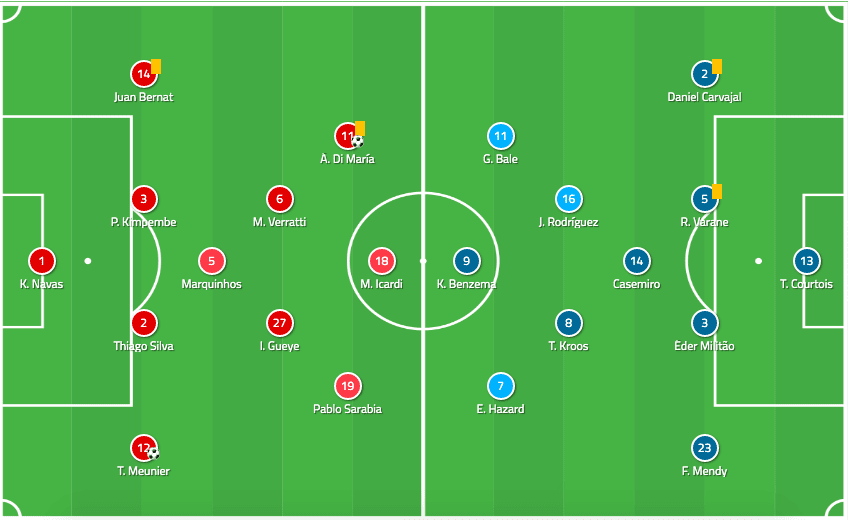
PSG’s central press and defensive shape
In the first half, PSG sat back and allowed Real Madrid to bring the ball forward. This was particularly the case after their first goal, where for the following fifteen minutes they allowed 29 passes per defensive action.
Initially, they kept their 4-3-3 shape in defence. However, it was not unusual to see them drop at times to a 5-4-1 throughout the second half, with one of the midfield three dropping into central defence if Madrid were attacking in a high area.
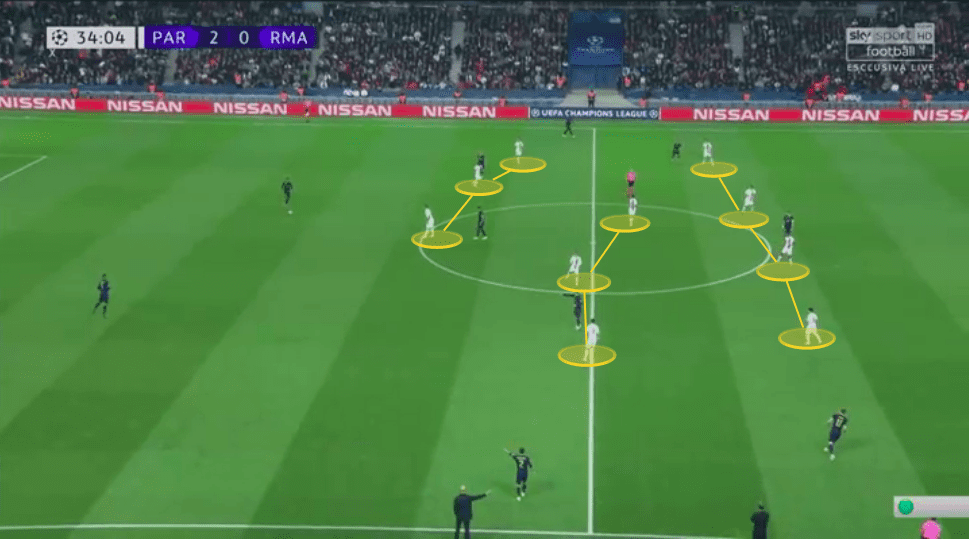
However, after halftime, their approach changed and Tuchel had them engage in a high press. They allowed only 8.8 PPDA for the duration of the second half.
In order to prevent Real Madrid from playing out from the back, Tuchel had his side take a very narrow defensive shape. They created a central diamond, as the analysis below shows, preventing Real from being able to play through central areas.
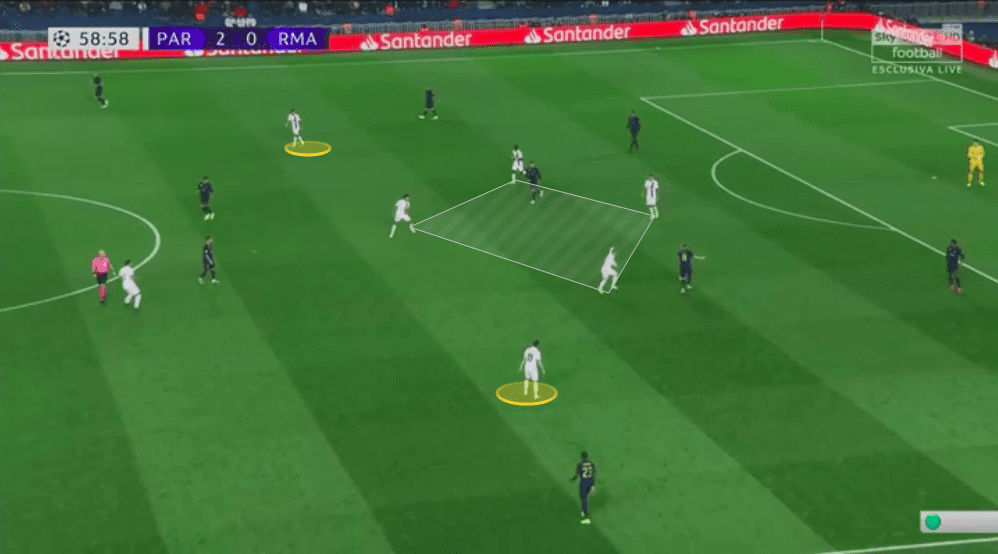
As well as this central four, they dropped two players either side of this diamond in order to block passing lanes for Kroos to play through. Tuchel wanted PSG to force Real Madrid to have to play wid, or they would win the ball back in central areas. PSG were successful at this, with all three of their counter attacks in the game coming from the centre of the pitch. They had an xG of 0.57 from these three opportunities too.
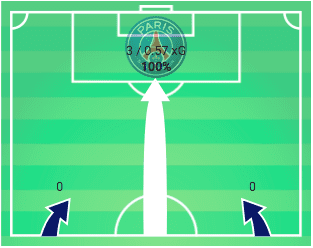
There was an emphasis on keeping a tight, narrow defensive shape. PSG were able to successfully win the ball back the ball in central areas throughout the game, and 42% of their ball recoveries came in the middle of the pitch. This shows a commitment to this tactic, particularly when compared with Real Madrid who had only 30% of their ball recoveries coming in central areas. By winning the ball back in these positions they could counter from the middle, as mentioned above, but most importantly stop Kroos from setting the tempo.
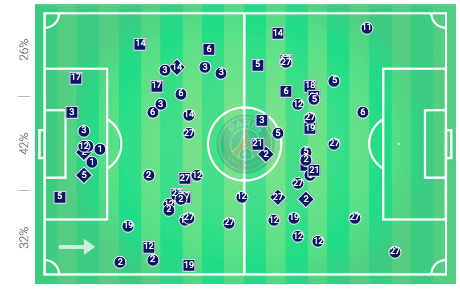
Real Madrid’s pass map shows a distinct lack of penetrative passes from the middle of the pitch. Kroos was frequently forced to play the ball laterally or backwards. The German midfielder and his teammates, Casemiro and James, were heavily restricted in their attempts to pass the ball into Benzema.
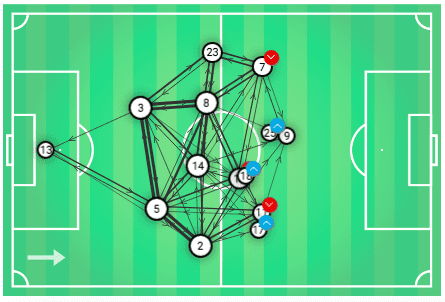
Kroos was unable to get a real hold on the game and was unsuccessful in creating attacking opportunities, with only one attempted pass into the 18-yard box, which was intercepted. In last weekend’s 3-2 win over Levante, he successfully completed four of his five attempted passes into the 18-yard box. He also lost the ball four times in his own half, having only lost the ball once in his own half for Real Madrid for the rest of the season so far. Casemiro also lost the ball seven times in his own half.
Real Madrid’s attacking woes
Real were ineffective going forward throughout the game. Other than Gareth Bale’s goal that was disallowed for handball, they didn’t hit the target once from their nine shots on goal. PSG’s defensive shape was excellent at preventing them from breaking the lines and getting shots away close to goal.
The statistics back this up with Real’s average shot distance of 20.38 yards, far higher than PSG’s 14.32 yards. Their xG per shot averaged out at just 0.07 too, suggesting the shots they were taking weren’t of high quality either. In contrast, PSG had an average xG of 0.19 for each of their nine shots on goal.
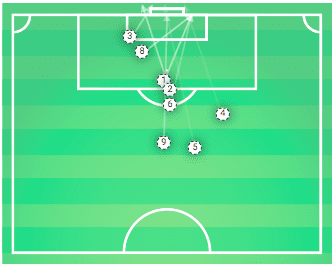
Karim Benzema has been in excellent form thus far for Real Madrid this season, scoring four goals, and averaging 3.82 shots per game in the league. However, he was restricted to just two shots in this game. Luka Jović’s struggles continued, and he was brought on as a second-half substitute but didn’t manage a single shot. He has only managed three shots in his five appearances so far for Zidane’s side. A lot can be said for PSG’s defensive shape, however, this attacking output from their forwards is incredibly disappointing.
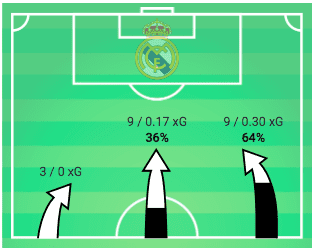
Zidane opted to focus the majority of Real’s play down the right-hand side and attack PSG’s left-back Juan Bernat. This was an interesting choice considering he has been solid for PSG thus far this year, yet right-back Thomas Meunier was making only his second start this season.
Seven of Real’s eight crosses came from the right side, with Dani Carvajal attempting the most with four crosses. However, only three crosses made their way into the area.
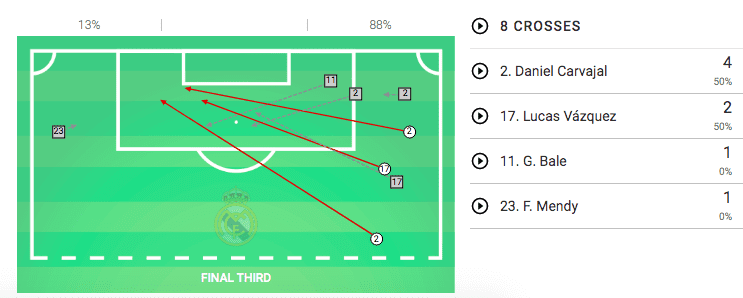
Perhaps Zidane though Di María was less likely to drop back and support Bernat, however, he was committed to his defensive duties throughout the game, and Real were generally unsuccessful in their attempts to exploit PSG’s left side.
Di María was used to drop back and prevent Bale from being given too much space or allowing him to be left in a 1v1 situation. Below shows this as well as the aforementioned low block that PSG used in the first half to stifle Madrid’s attacks.
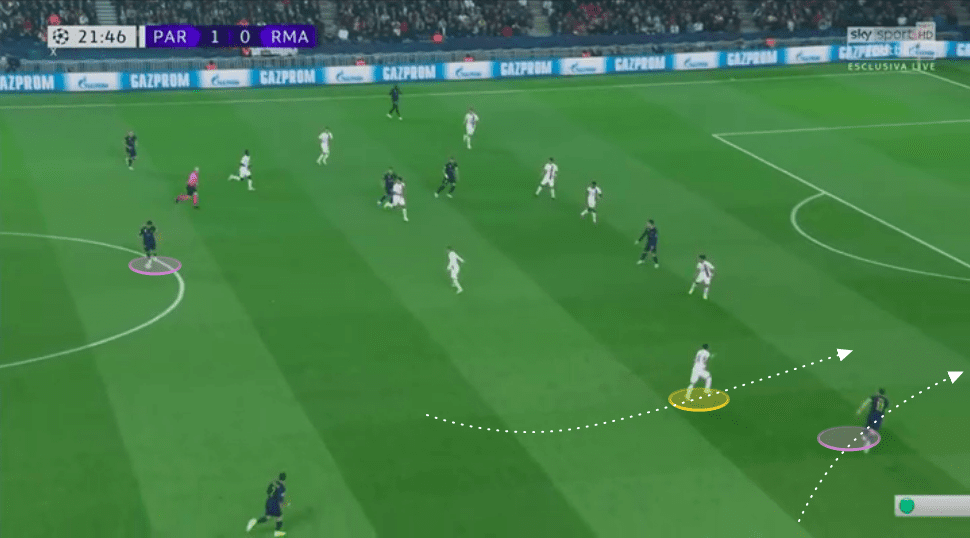
How PSG found space in between the Real Madrid centre-backs
Tuchel looked to create space between Real Madrid’s centre-backs Éder Militão and Raphaël Varane. The plan began with their shape in their build-up play. Both full-backs, Meunier and Bernat, pushed very high and provided the width in attack. This allowed PSG’s front three to play close to Real Madrid’s back four. Due to Real also using a 4-3-3 with a narrow middle three, this meant both Meunier and Bernat were able to push high in attack and therefore Real Madrid’s own full-backs had to move across in order to engage them.
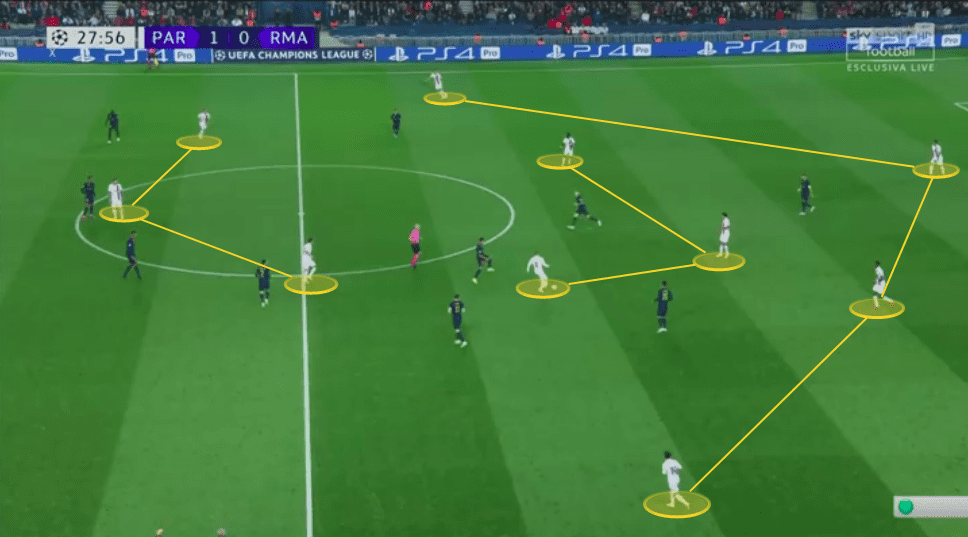
This was exactly what happened for the first goal as Bernat found space down the left-flank. Carvajal had to move across to close him down. Icardi, the central striker of PSG’s front three, moved across to provide an option for Bernat. As Varane followed Icardi this created huge space between himself and Militão – space which Di María was able to move into in order to latch onto Bernat’s cross and score.
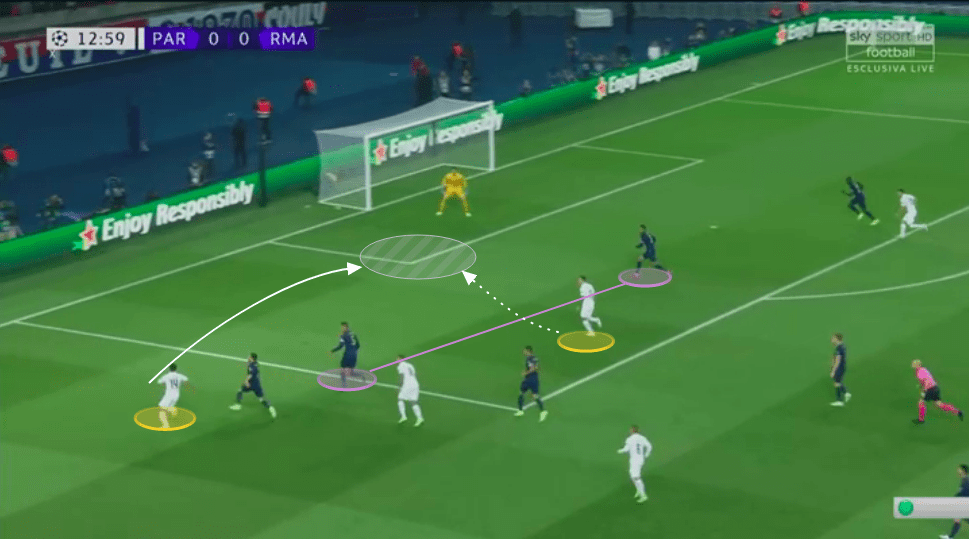
It was the same from either flank and Real were fortunate not to concede more with their back four struggling to avoid being pulled around and losing their shape for the majority of the first half. PSG also engaged in quick interchanges in the half-spaces between centre-back and full-back in order to draw out Madrid’s defence. At times the space between the two centre-backs was quite staggering.
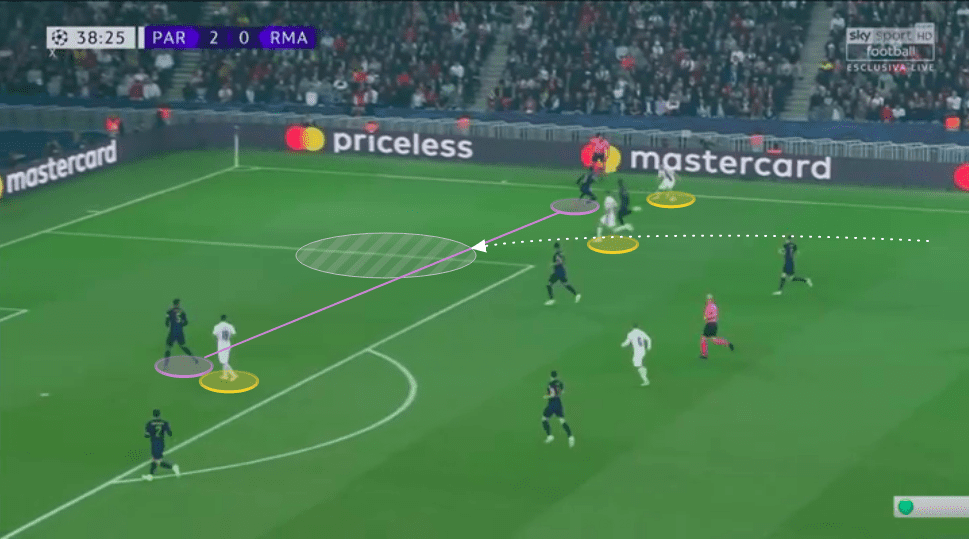
Conclusion
PSG were deserved winners on the evening, and will hope it is the beginning of a Champions League campaign that doesn’t end in underwhelming fashion.
Despite having reasonable possession, Real Madrid did very little to concern Keylor Navas. Zidane has a side full to the brim with new signings and it may take some time to gel – it was only Eden Hazard’s second game.
However, it was surprising to see a team with Hazard and Bale, playing either side of Benzema, penetrate PSG’s backline without much success. That is a credit to Tuchel’s defensive tactics and PSG’s willingness to defend well in a low block in the first half, and successfully press as a unit in the second half.

If you love tactical analysis, then you’ll love the digital magazines from totalfootballanalysis.com – a guaranteed 100+ pages of pure tactical analysis covering topics from the Premier League, Serie A, La Liga, Bundesliga and many, many more. Buy your copy of the August issue for just ₤4.99 here




Comments